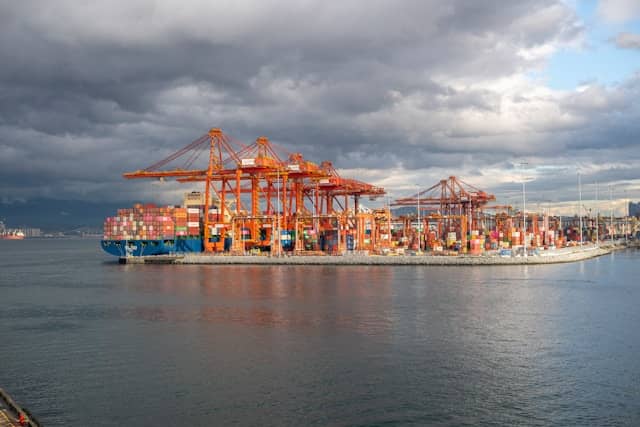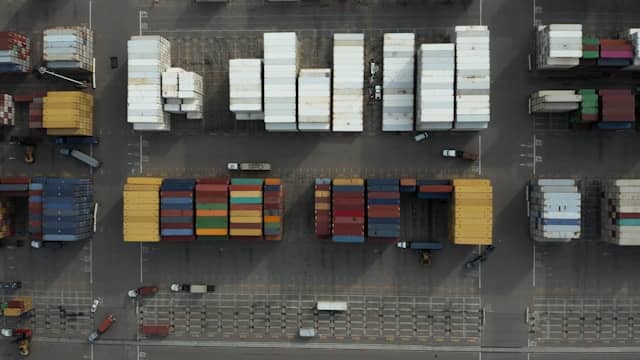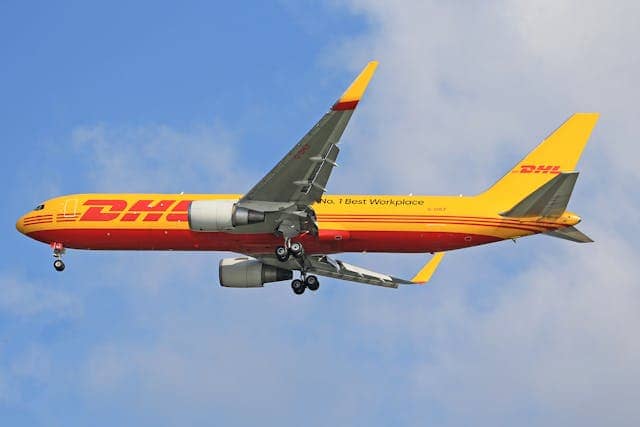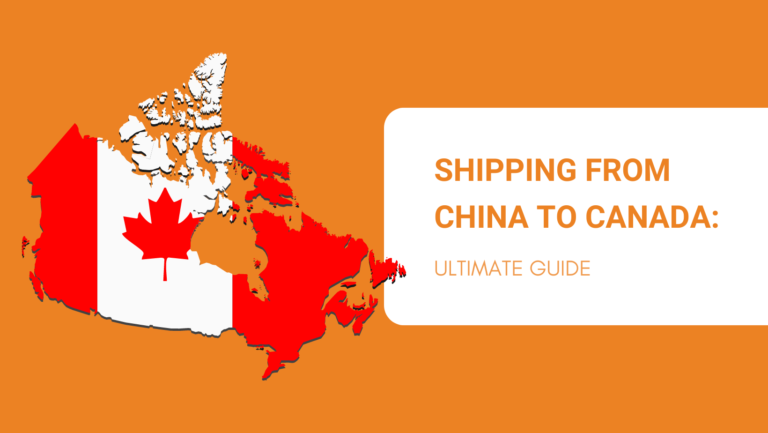The process of shipping from China to Canada can feel daunting, but it’s a vital aspect of international trade.
With growing trade relations between the two nations, understanding logistics and efficient shipping practices is crucial.
This guide offers a comprehensive look at different shipping methods, cost factors, customs regulations, and tips for managing your shipping efficiently.
These insights aim to help you easily navigate the process of shipping from China to Canada and make informed decisions.
Key Takeaways
- Different shipping methods offer various trade-offs in cost and time.
- Understanding cost factors and customs regulations is essential.
- Efficient shipping management ensures quicker and cost-effective delivery.

Shipping Methods from China to Canada
Choosing the right shipping method depends on various factors such as cost, speed, and the nature of the goods being transported. Below are the primary shipping methods available for transporting goods from China to Canada.
Air Freight
Air freight involves transporting goods via cargo planes, which offer the fastest shipping times. It’s ideal for high-value and urgent shipments. Airlines work with freight forwarders to handle the logistics, ensuring that goods reach destinations quickly.
Pros
- Speed: Typically 3-5 days for delivery.
- Reliability: Consistent schedules and fewer delays.
- Security: High value and sensitive goods are well-protected.
Cons
- Cost: More expensive than sea freight.
- Limitations: Weight and size restrictions.
- Accessibility: Limited to cities with major airports.
Sea Freight
Sea freight uses container ships to transport large volumes of goods and is the most economical choice for heavy or bulk shipments.
It operates on Full Container Load (FCL) and Less Than Container Load (LCL) options, accommodating different shipment sizes.
Pros
- Affordability: Cost-effective for large and heavy items.
- Versatility: Suitable for various goods, from electronics to furniture.
- Environmental Impact: Lower carbon footprint compared to air freight.
Cons
- Time: Takes longer, typically 20-40 days.
- Unpredictability: Weather and port congestion can cause delays.
- Complexity: Involves more documentation and customs clearance.
Express Shipping
Express shipping uses services like DHL, FedEx, and UPS to deliver parcels quickly. It often includes door-to-door shipping, making it convenient for smaller, time-sensitive packages.
Pros
- Speed: Deliveries in as few as 1-3 days.
- Convenience: Comprehensive tracking and door-to-door service.
- Reliability: High consistency in delivery times.
Cons
- Expense: The most expensive method.
- Size Limitations: Not feasible for large, bulky shipments.
- Customs Delays: Potential for hold-ups at customs.
Selecting the appropriate shipping method involves balancing cost, speed, and the specific needs of your shipment.
Top-Rated China Freight Forwarder
Expert Shipping Solutions for Your Needs
Key Ports in China and Canada

When shipping goods from China to Canada, understanding the key ports involved is essential for making informed decisions.
Chinese ports like Shanghai, Shenzhen, Ningbo, and Guangzhou are some of the busiest in the world, while Canadian ports such as Vancouver, Montreal, and Halifax play a crucial role in facilitating imports.
Key Ports in China
Port of Shanghai
The Port of Shanghai is the world’s busiest container port, with a handling capacity of over 42 million TEUs (Twenty-Foot Equivalent Units) annually.
Open for international trade since 1842, it is crucial for shipping goods such as electronics, textiles, and machinery. Its extensive infrastructure and facilities make it a preferred choice for many businesses.
Port of Shenzhen
Shenzhen port is another major hub, strategically located in Guangdong province. This port handles around 27 million TEUs each year.
It is instrumental for exports of high-tech goods and consumer electronics, thanks to its proximity to numerous manufacturing plants and its advanced logistics services.
Port of Ningbo
Located in Zhejiang province, Ningbo port has a capacity of approximately 26 million TEUs annually. It plays a significant role in exporting machinery and consumer goods.
The port’s deep-water berths and efficient rail connectivity enhance its role in global supply chains.
Port of Guangzhou
The Port of Guangzhou handles around 23 million TEUs per year and is vital for the export of machinery, consumer goods, and raw materials. Its advanced facilities, including modern warehouses, make it essential for efficient global trade.
Key Ports in Canada
Port of Vancouver
The Port of Vancouver is Canada’s largest and busiest port, handling over 3.5 million TEUs yearly. It is critical for receiving consumer goods, electronics, and machinery from China.
Its strategic location on the West Coast makes it a gateway for Pacific trade and provides easy access to major Canadian markets.

Port of Montreal
The Port of Montreal serves as a crucial entry point for goods coming from China to Eastern Canada. Handling around 1.5 million TEUs annually, it specializes in the import of raw materials, consumer goods, and machinery.
Its connection to the Great Lakes and rail networks ensures efficient distribution.
Port of Halifax
Located on the East Coast, the Port of Halifax handles approximately 550,000 TEUs each year. This port is significant for importing electronics, textiles, and raw materials from China.
Its deep-water berths and modern facilities support the efficient handling and distribution of goods.
Cost Factors in Shipping from China to Canada
Several factors influence the cost of shipping goods from China to Canada, including the chosen method and additional charges. Knowing these details can help you make informed shipping decisions.
Shipping Costs by Method
Different shipping methods have varying costs. For instance, air freight and express shipping are faster but more expensive. In contrast, sea freight is economical for large shipments, though it takes longer.
Here is a brief summary of the costs:
| Shipping Method | Ideal For | Cost Range |
| Sea Freight (FCL) | Larger shipments | $2,000 – $4,000 |
| Sea Freight (LCL) | Smaller shipments | $200 – $400 per pallet |
| Air Freight | Urgent shipments | $500 – $1,000 per 100 kg |
| Express Shipping | Very urgent, small packages | From $100 |
Additional Charges
Shipping costs are not limited to the base rates. Additional fees also impact the final amount.
Fuel surcharges can vary with fluctuating oil prices, sometimes adding a significant amount to the total cost. For instance, a 15% surcharge on a $3,000 shipment adds $450.
Seasonal peak surcharges may apply, especially during busy periods like holidays. Planning your shipments around these times can help avoid extra costs.

Handling fees cover the logistics of moving goods through ports and ensure timely processing. These can add an extra $200-$300 to your bill.
Insurance is another crucial factor. Ensuring your shipment against loss or damage is a prudent step, often adding about 1-2% of the shipment value to your total cost, depending on the coverage level.
Customs and Regulations
When shipping from China to Canada, customs and regulations can be complex. Understanding required documentation and the customs clearance process is essential for smooth shipping.
Required Documentation
To import goods from China to Canada, you need specific documents. A commercial invoice outlines the transaction between buyer and seller, detailing the value of goods. This is crucial for determining duties and taxes.
A packing list provides a detailed summary of the shipment’s contents. It helps customs authorities verify the items in the shipment against the commercial invoice.
A bill of lading serves as a contract between the shipper and carrier, confirming receipt of goods for shipment. It is also important for transferring ownership of the goods.
The certificate of origin verifies where the goods were manufactured. This document can affect duty rates and ensure compliance with trade agreements.
Having these documents ready and accurately completed can prevent delays and additional costs. Always consult with your freight forwarder to ensure all paperwork is in order.
Customs Clearance Process
Clearing customs involves several steps, beginning with a declaration to the Canada Border Services Agency (CBSA). This declaration includes the nature, quantity, and value of the goods being imported.
Following the declaration, the shipment may be subject to an inspection. Inspections ensure compliance with Canadian regulations and may involve checking for prohibited items or verifying documentation.

You will need to pay duties and taxes. Import duties can vary, but for instance, a 5% duty rate on a $10,000 shipment adds $500. Additionally, there is a 15% VAT, adding another $1,500, raising total costs significantly.
Utilizing a reputable freight forwarder can streamline this process. They can assist with the necessary declarations and ensure all regulatory standards are met.
Transit Times from China to Canada
Shipping times from China to Canada can vary significantly depending on the mode of transportation you choose. Here is a breakdown of typical transit times:
| Shipping Mode | Transit Time |
| Express Shipping | 1-3 days |
| Air Freight | 3-5 days |
| Sea Freight | 20-40 days |
Express Shipping is the fastest option, taking between 1 to 3 days. This method is ideal for urgent shipments, but it tends to be the most expensive.
Air Freight provides a balance between speed and cost, generally taking around 3 to 5 days. The exact time can fluctuate based on factors such as the specific airports used and the weight of your shipment.
Sea Freight is the slowest but most cost-effective option. It takes approximately 20 to 40 days for goods to travel from China to Canada by sea. This option is suitable for large shipments that are not time-sensitive.
Several factors can influence transit times:
- Weather Conditions: Bad weather can delay ships and planes.
- Port Congestion: Busy ports can result in delays, especially during peak seasons.
- Customs Processing Times: Clearing customs can add time if your documents or goods get held up for inspection.
Using reliable logistics companies can help manage these uncertainties by providing real-time tracking and updates.
Top-Rated China Freight Forwarder
Expert Shipping Solutions for Your Needs
How to Choose the Right Freight Forwarder from China to Canada
Choosing the right freight forwarder can significantly improve your shipping experience. Here’s a step-by-step guide to help you find the best freight forwarder from China to Canada.

1. Check Credentials and Certifications.
Ensure the freight forwarder is certified and has all the necessary licenses to operate. Look for affiliations with recognized industry bodies. This can give you confidence in their credibility and professionalism.
2. Evaluate Experience.
Look for a freight forwarder with extensive experience in shipping from China to Canada. Experienced forwarders will have a better understanding of the routes, regulations, and potential challenges.
3. Review the Range of Services.
Opt for a forwarder who offers a comprehensive range of services such as customs clearance, warehousing, and insurance. This can simplify your logistics by having all services under one roof.
4. Read Customer Reviews.
Customer reviews provide insights into the forwarder’s reliability and efficiency. Look for feedback on their service quality, communication, and problem-solving abilities.
5. Compare Costs.
Get quotes from multiple freight forwarders and compare their costs. Make sure to understand what each quote includes to avoid hidden fees or unexpected charges.
6. Assess Technology and Tracking.
Choose a forwarder that provides advanced tracking systems and digital tools. This ensures you have real-time updates on the status of your shipment.
7. Verify Industry Reputation.
Use industry guides and directories to find reputable freight forwarders.
Tips for Efficient Shipping Management
1. Consolidate Shipments.
Combining smaller shipments into one larger one reduces costs. This method, known as consolidation, leverages sea freight for cost-effective shipping.
2. Optimize Packaging.
Proper packaging ensures your goods take up the least space. This reduces dimensional weight charges and protects items from damage. Sturdy, well-packed merchandise minimizes shipping problems.
3. Use Technology for Tracking.
Leverage tracking systems to monitor your shipments. Real-time updates help manage logistics efficiently. You’ll know exactly where your inventory is at all times.
4. Choose the Right Mode of Transport.
If your shipment isn’t urgent, select sea freight for its lower cost. For urgent deliveries, air freight offers speedier service despite being more expensive. Evaluate cost vs. time to make the best decision.

5. Work with Reputable Freight Forwarders.
Partner with reliable freight forwarders who offer comprehensive services. This can include customs clearance, which shortens processing time and simplifies documentation. It’s especially useful when shipping to FBA.
6. Leverage Alibaba Shipping Services.
When sourcing products from Alibaba, consider their shipping services for simplicity. They offer competitive rates and streamline the entire shipping process from vendor to doorstep.
7. Regularly Review Shipping Costs.
Stay updated with the latest shipping rates and adjust your strategy accordingly. Rates can fluctuate due to factors like fuel prices and port congestion. For example, recent ocean rates have experienced a 13% increase to $4,917 per FEU.
FAQs about Shipping from China to Canada
Shipping from China to Canada involves careful planning and understanding of regulations. Below are some common concerns along with practical tips and guidelines to ensure a smooth process.
How to Optimize Packaging and Handling When Shipping from China to Canada?
To reduce costs and minimize damage, use appropriate materials and sizes for your packaging. Opt for sturdy, lightweight packaging that meets industry standards.
For instance, double-walled corrugated boxes can offer better protection for fragile items. Utilize inserts and cushioning materials to prevent movement during transit.
What Are the Duties for Shipping from China to Canada?
Duty rates and taxes depend on the type and value of the imported goods. Import duty is computed based on the item’s value, with varying rates detailed in the CBSA tariff schedule.
You can use the Canadian Border Services Agency (CBSA) calculator to estimate your duties. GST of 5% is also applicable.
What Items Are Prohibited from China to Canada?
Certain items are restricted or prohibited from being shipped to Canada. These include specific chemicals, certain plants, and animal products.
Refer to the CBSA and Health Canada regulations for a comprehensive list of prohibited items to ensure compliance.
Who Is the Best Shipping Agent from China to Canada?
Selecting a top shipping agent involves considering their experience, service range, and customer reviews. NicheSources, for instance, stands out due to its comprehensive services and positive feedback.
You can check shipping agent directories and customer testimonials to find the most reliable option for your needs.
Wrapping Up: Efficient Strategies for Shipping from China to Canada
Shipping from China to Canada involves selecting the right shipping method, understanding cost factors, and managing customs regulations effectively.
For a seamless shipping experience, consider partnering with NicheSources. We offer comprehensive freight forwarding services from China to Canada. Request a quote from us today to ensure your shipments are handled professionally and cost-effectively.

